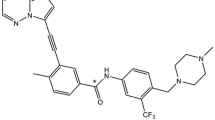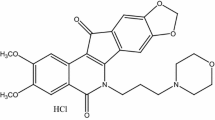Summary
Background Vosaroxin is a first-in-class anticancer quinolone derivative that is being investigated for patients with relapsed or refractory acute myeloid leukemia (AML). The primary objective of this study was to quantitatively determine the pharmacokinetics of vosaroxin and its metabolites in patients with advanced solid tumors. Methods This mass balance study investigated the pharmacokinetics (distribution, metabolism, and excretion) of vosaroxin in cancer patients after a single dose of 60 mg/m2 14C–vosaroxin, administered as short intravenous injection. Blood, urine and feces were collected over 168 h after injection or until recovered radioactivity over 24 h was less than 1% of the administered dose (whichever was earlier). Total radioactivity (TRA), vosaroxin and metabolites were studied in all matrices. Results Unchanged vosaroxin was the major species identified in plasma, urine, and feces. N-desmethylvosaroxin was the only circulating metabolite detected in plasma, accounting for <3% of the administered dose. However, in plasma, the combined vosaroxin + N-desmethylvosaroxin AUC0-∞ was 21% lower than the TRA AUC0-∞ , suggesting the possible formation of protein bound metabolites after 48 h when the concentration-time profiles diverged. The mean recovery of TRA in excreta was 81.3% of the total administered dose; 53.1% was excreted through feces and 28.2% through urine. Conclusions Unchanged vosaroxin was the major compound found in the excreta, although 10 minor metabolites were detected. The biotransformation reactions were demethylation, hydrogenation, decarboxylation and phase II conjugation including glucuronidation.







Similar content being viewed by others
References
Evanchik MJ, Allen D, Yoburn JC, Silverman JA, Hoch U (2009) Metabolism of (+)-1,4-dihydro-7-(trans-3-methoxy-4-methylamino-1-pyrrolidinyl)-4-oxo-1-(2-thiaz olyl)-1,8-naphthyridine-3-carboxylic acid (voreloxin; formerly SNS-595), a novel replication-dependent DNA-damaging agent. Drug Metab Dispos 37(3):594–601. doi:10.1124/dmd.108.023432
Hawtin RE, Stockett DE, Wong OK, Lundin C, Helleday T, Fox JA (2010) Homologous recombination repair is essential for repair of vosaroxin-induced DNA double-strand breaks. Oncotarget 1(7):606–619
Mjos KD, Cawthray JF, Jamieson G, Fox JA, Orviga C (2014) Iron(III)-binding of the anticancer agents doxorubicin and vosaroxin. Dalton Trans 44(5):2348–2358. doi:10.1039/c4dt02934h
Lancet JE, Ravandi F, Ricklis RM, Cripe LD, Kantarjian HM, Giles FJ, List AF, Chen T, Allen RS, Fox JA, Michelson GC, Karp JE (2011) A phase Ib study of vosaroxin, an anticancer quinolone derivative, in patients with relapsed or refractory acute leukemia. Leukemia 25(12):1808–1814. doi:10.1038/leu.2011.157
Lancet JE, Roboz GJ, Cripe LD, Michelson GC, Fox JA, Leavitt RD, Chen T, Hawtin R, Craig AR, Ravandi F, Maris MB, Stuart RK, Karp JE (2015) A phase 1b/2 study of combination vosaroxin and cytarabine in patients with relapsed or refractory acute myeloid leukemia. Haematologica 100(2):231–237
Ravandi F, Ritchie EK, Sayar H, Lancet JE, Craig MD, Vey N, Strickland SA, Schiller GJ, Jabbour E, Erba HP, Pigneux A, Horst HA, Recher C, Klimek VM, Cortes J, Roboz GJ, Odenike O, Thomas X, Havelange V, Maertens J, Derigs HG, Heuser M, Damon L, Powell BL, Gaidano G, Carella AM, Wei A, Hogge D, Craig AR, Fox JA, Ward R, Smith JA, Acton G, Mehta C, Stuart RK, Kantarjian HM (2015) Vosaroxin plus cytarabine versus placebo plus cytarabine in patients with first relapsed or refractory acute myeloid leukaemia (VALOR): a randomised, controlled, double-blind, multinational, phase 3 study. Lancet Oncol. doi:10.1016/S1470-2045(15)00201-6
Stuart RK, Cripe LD, Maris MB, Cooper MA, Stone RM, Dakhil SR, Turturro F, Stock W, Mason J, Shami PJ, Strickland SA, Costa LJ, Borthakur G, Michelson GC, Fox JA, Leavitt RD, Ravandi F (2015) REVEAL-1, a phase 2 dose regimen optimization study of vosaroxin in older poor-risk patients with previously untreated acute myeloid leukemia. Br J Haematol 168(6):796–805
Advani RH, Hurwitz HI, Gordon MS, Ebbinghaus SW, Mendelson DS, Wakelee HA, Hoch U, Silverman JA, Havrilla NA, Berman CJ, Fox JA, Allen RS, Adelman DC (2010) Voreloxin, a first-in-class anticancer quinolone derivative, in relapsed/refractory solid tumors: a report on two dosing schedules. Clin Cancer Res 16(7):2167–2175. doi:10.1158/1078-0432.CCR-09-2236
Nijenhuis CM, Lucas L, Rosing H, Jamieson G, Fox JA, Schellens JH, Beijnen JH (2016) Quantification of vosaroxin and its metabolites N-desmethylvosaroxin and O-desmethylvosaroxin in human plasma and urine using high-performance liquid chromatography-tandem mass spectrometry. J Chromatogr B Analyt Technol Biomed Life Sci 1027:1–10. doi:10.1016/j.jchromb.2016.05.016
Food US, Administration D (2008) FDA guidance for industry: safety testing for drug metabolites. US Department of Health and Human, Services Food and Drug Administration, Center for Drug Evaluation and Research http://www.fda.gov/OHRMS/DOCKETS/98fr/FDA-2008-D-0065-GDL.pdf
European Medicines Agency. Guide to bioanalytical method validation. Committee for Medicinal Products for Human Use and European Medicines Agency (2011) http://www.ema.europa.eu/docs/en_GB/document_library/Scientific_guideline/2011/08/WC500109686.pdf
Davies B, Morris T (1993) Physiological parameters in laboratory animals and humans. Pharm Res 10(7):1093–1095
ICH. Topic M 3 (R2) (2008) Non-Clinical Safety Studies for the Conduct of Human Clinical Trials and Marketing Authorization for Pharmaceuticals. http://www.ema.europa.eu/docs/en_GB/document_library/Scientific_guideline/2009/09/WC500002941.pdf
Roffey SJ, Obach RS, Gedge JI, Smith DA (2007) What is the objective of the mass balance study? A retrospective analysis of data in animal and human excretion studies employing radiolabeled drugs. Drug Metab Rev 39(1):17–43. doi:10.1080/03602530600952172
Acknowledgements
Medical writing assistance was provided by Janis Leonoudakis, PhD of Powered 4 Significance, LLC.
Author information
Authors and Affiliations
Corresponding author
Ethics declarations
Conflict of interest
GCJ is employed by Sunesis Pharmaceuticals. JAF was previously employed by and is a consultant for Sunesis Pharmaceuticals. DRM is president of Projections Research ink, a consulting company to the pharmaceutical industry. CMN, LL, HR, ADRH, MM-R, JHMS, and JHB have no conflicts of interest to declare.
Funding
This work was financially supported and sponsored by Sunesis Pharmaceuticals, Inc. Medical writing assistance was funded by Sunesis Pharmaceuticals, Inc.
Ethical approval
All procedures in this study were conducted in accordance with the ethical standards of the International Conference on Harmonisation guidelines for Good Clinical Practice, the code of Federal Regulations, and the European Union Directive. The protocol was approved by The Netherlands Cancer Institute Independent Ethics Committee.
Informed consent
Written, informed consent was obtained from all individual participants at the time of screening.
Rights and permissions
About this article
Cite this article
Nijenhuis, C., Lucas, L., Rosing, H. et al. Metabolism and disposition of the anticancer quinolone derivative vosaroxin, a novel inhibitor of topoisomerase II. Invest New Drugs 35, 478–490 (2017). https://doi.org/10.1007/s10637-017-0428-1
Received:
Accepted:
Published:
Issue Date:
DOI: https://doi.org/10.1007/s10637-017-0428-1




